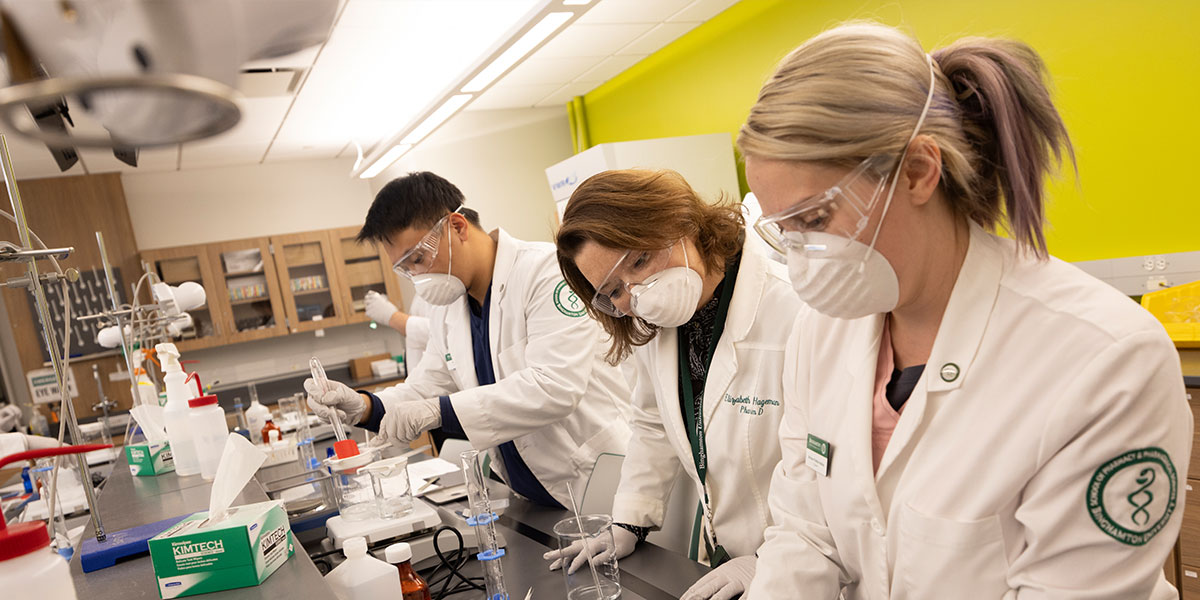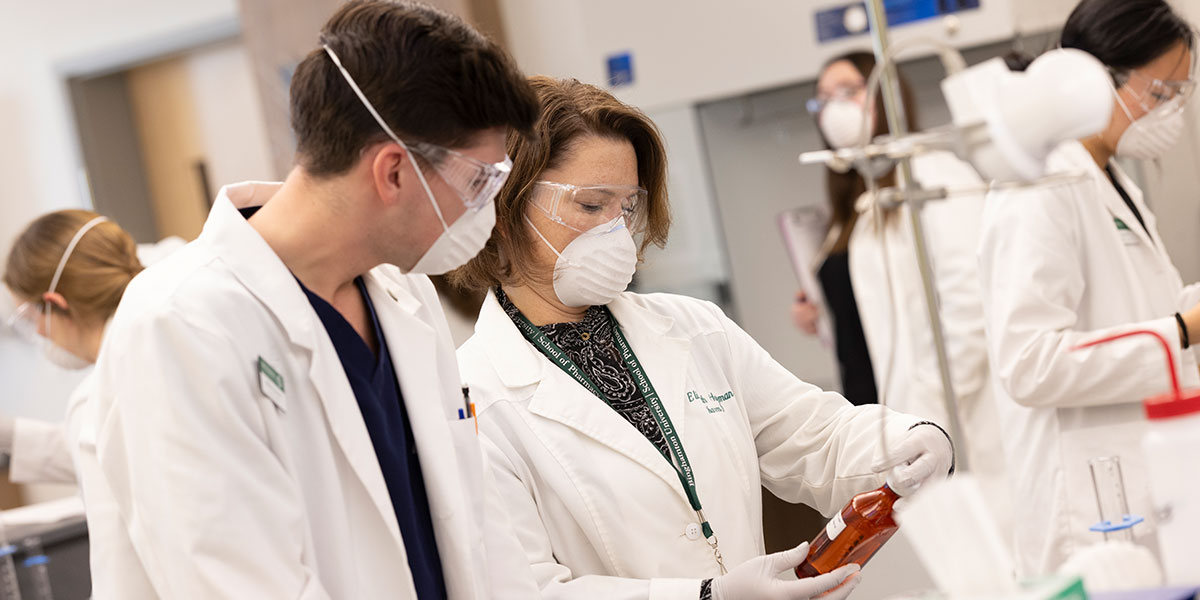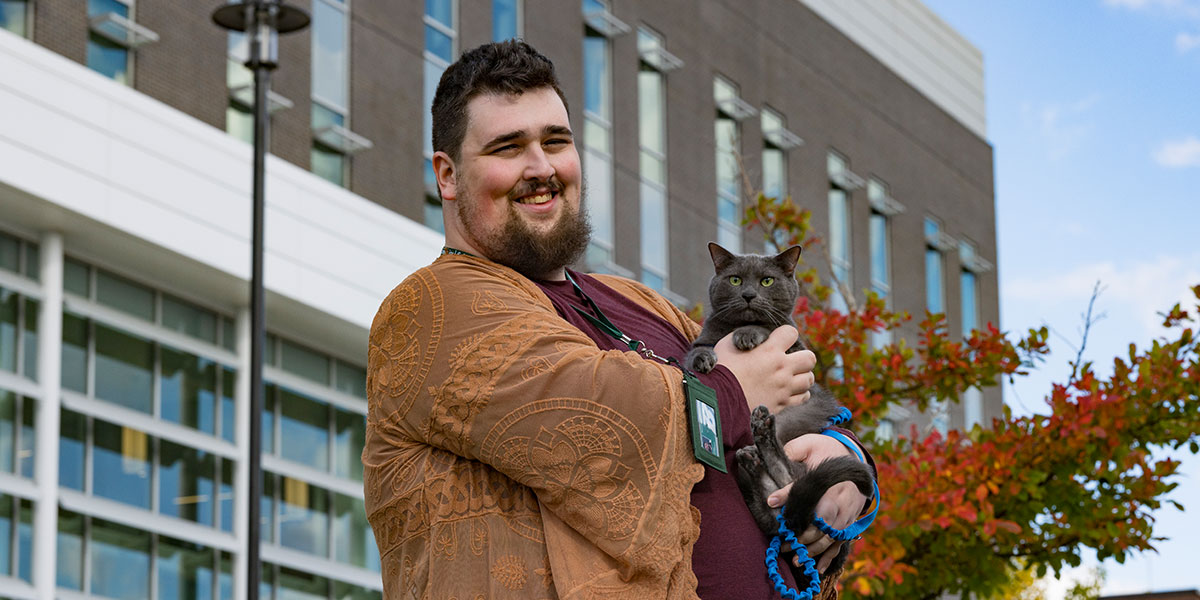The mix and the measure: Teaching students the science behind making medicine
Binghamton University’s School of Pharmacy teaches students the science behind making medicines

Apothecaries, precursors to modern-day pharmacists, can be dated back to ancient Babylon. They were known to provide “potions” on demand. In Shakespeare’s Romeo and Juliet, it’s an apothecary who provides the fatal dose.
These days, though, measuring out medicines and mixing them together — also known as compounding — is a specific science aimed at improving the patient’s quality of life.
BOOTS ON THE GROUND
“We know the compound and the actual active pharmaceutical ingredient, which in theory is a pure molecule that has been created at a manufacturing plant and has the FDA seal of approval,” says Elizabeth Hageman ’95, assistant director of skills education and a clinical assistant professor of pharmacy practice at
the School of Pharmacy and Pharmaceutical Sciences. “We are very specific with what the active ingredient is; we know the dosing, and we can deliver consistency with products.”
Compounding, in its broadest sense, is the preparation of medicines that fit the unique needs of individual patients. A number of common and high-demand drugs are mass-produced, but it isn’t economical to produce and stock every kind of medicine that patients need.
“I always tell the students that I’m here to teach you ‘boots on the ground.’ I need you to get a drug safely and correctly out the door,” Hageman says. “Pharmacy curricula cover many other pathways and topics, and there’s a lot of opportunities in the field — but this is one of those ‘Pharmacy 101’ topics. We need to make a drug for a patient and get it out the door, make sure it’s labeled correctly and make sure it’s safe.”
Hageman holds a doctorate in pharmacy; she grew up in the Binghamton area and is a Binghamton alumna, earning an undergraduate degree in environmental studies and sociology. Although she began her career teaching science in secondary school, she later moved into acute care with veterans and cancer patients. Hageman has headed the program that focuses on compounding since February 2022.
There are many reasons why a medicine might need to be compounded, including making the medication easier to ingest or apply, avoiding allergic reactions, adjusting dosing and even preference, via flavor or texture.
Another common form of compounding is the mixing of intravenous solutions in hospitals. Due to the risks of contamination, it’s known as “sterile compounding.” It is regulated and requires very strict procedures. Medication doses can change depending on a patient’s height, weight and lab work. A number of overarching individual parameters need to be considered, and each dose is unique.
“Creating sterile compounds is the backbone of treatments for a good percentage of hospital patients,” Hageman says. “In order for us to treat, especially in acute care settings like a hospital, patients are required many times to receive IV drugs. And our responsibility is to be able to produce those medications for patients within hospital systems.”
THE CAT’S MEOW
Compounding in pharmacies and hospitals isn’t the end of the story.
Nathan Potchinsky, office assistant in the Admissions Department at SOPPS, has firsthand experience with how compounding can impact lives. But it’s not because Potchinsky is a student or a patient working in the lab — it’s their feline friend who needs specialty medication.
“There are opportunities within the pharmacy world to actually specialize in veterinary compounding,” Hageman explains. “And not just for cats and dogs! They help large animals — they cover everything.”
Potchinsky joined the pharmacy school in July 2023. A few months before that, Potchinsky’s cat, Socks, was struggling. Although it is rare for animals to suffer from such ailments, Socks is extremely sensitive and often has skin reactions. He also had issues with anxiety and stress.
Socks had been prescribed medicine to help, but the bitter medicine had to be ingested and Socks wasn’t tricked by treats.
“It was the difference between either trying to get him to take a pill wrapped in a treat, which he would refuse to do, or forcing it down his throat, and even then he would still try to find ways to spit it out,” Potchinsky says. “That’s just a lot of stress for him and for us. It’s not good for your relationship with your pet to be doing that.”
After talking to the prescribing veterinarian, Potchinsky discovered that the medicine could be compounded.
TAKING A CHANCE
Potchinsky was initially cautious and concerned about the cost, effect and possible issues with a new medication. They learned the cost increase was relatively small and that compounding meant the medicine is tailored specifically to the patient — human or not. In this case, the medication was formulated into a topical gel that is applied inside Socks’ ear, where there is no fur to interfere with the application.
Potchinsky decided it was worth a try and ordered the medicine through a specialty compounding pharmacy. The medicine was made and shipped to Potchinsky’s door.
Now in gel form, taking the medicine was far less stressful and easier, for Socks and Potchinsky: “It worked pretty well for us in the end.”
Socks’ health has improved, and after about eight months, he no longer needs the medication.
When Potchinsky joined the pharmacy school team, they were amazed to learn they would be working where students were learning the same skills that had helped thier pet.
“That’s so cool that [the compounding lab is] here and that people are learning to do that because it’s not something that is ever going to fully be obsolete,” Potchinsky says. “It’s good to know that the pharmacy school is a place that’s teaching it — to feel like you’re at an institution that goes above and beyond.”


